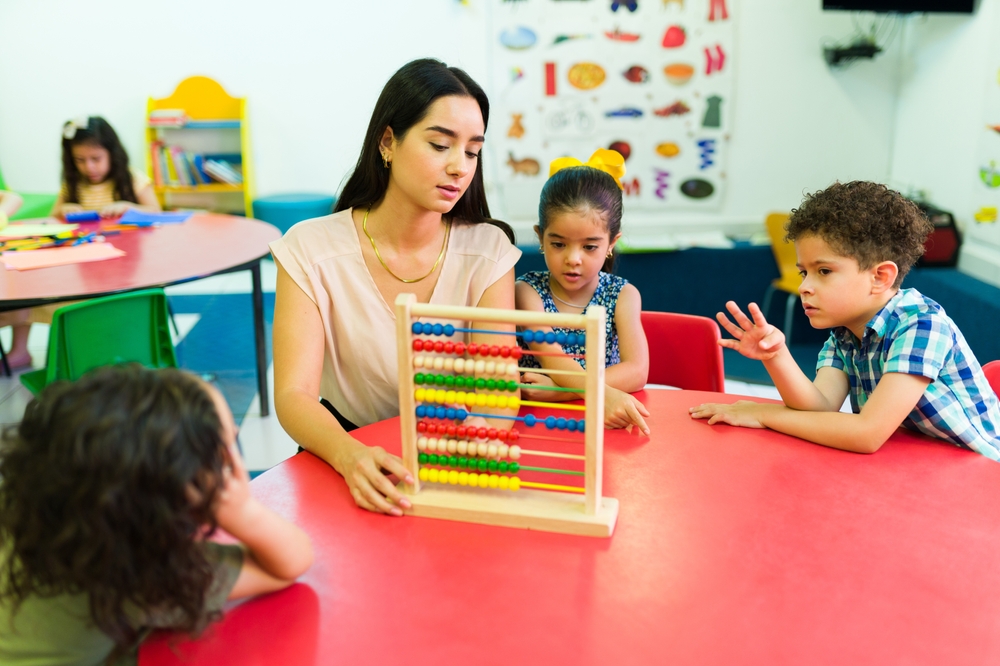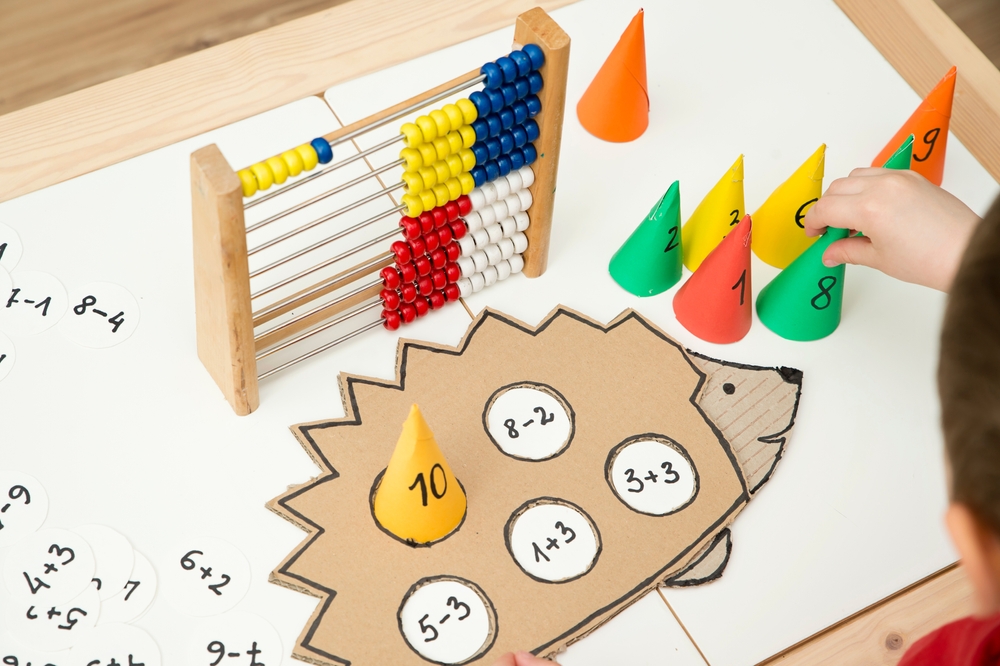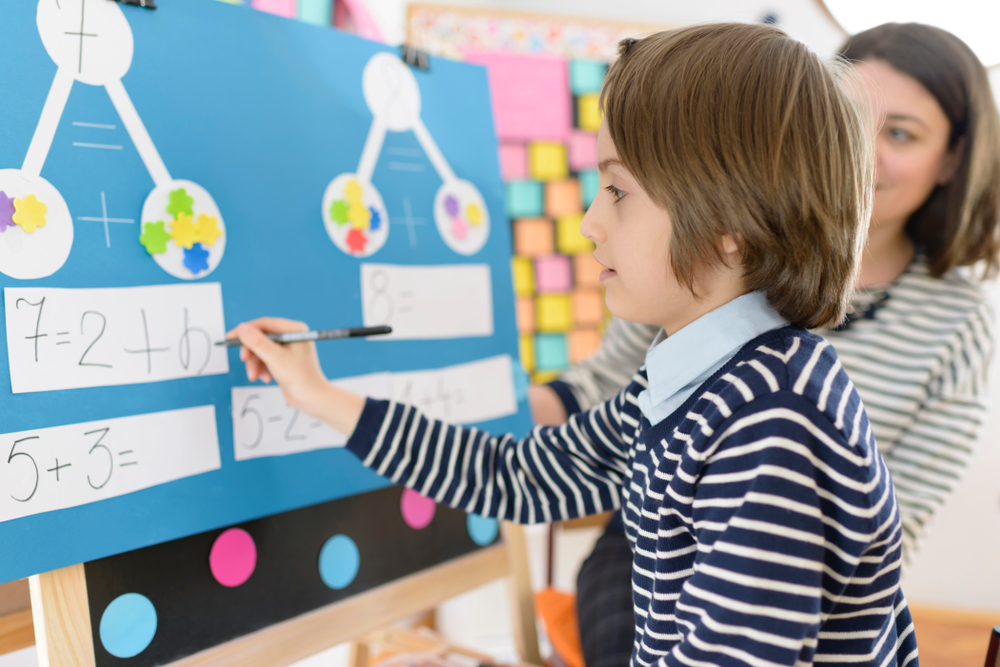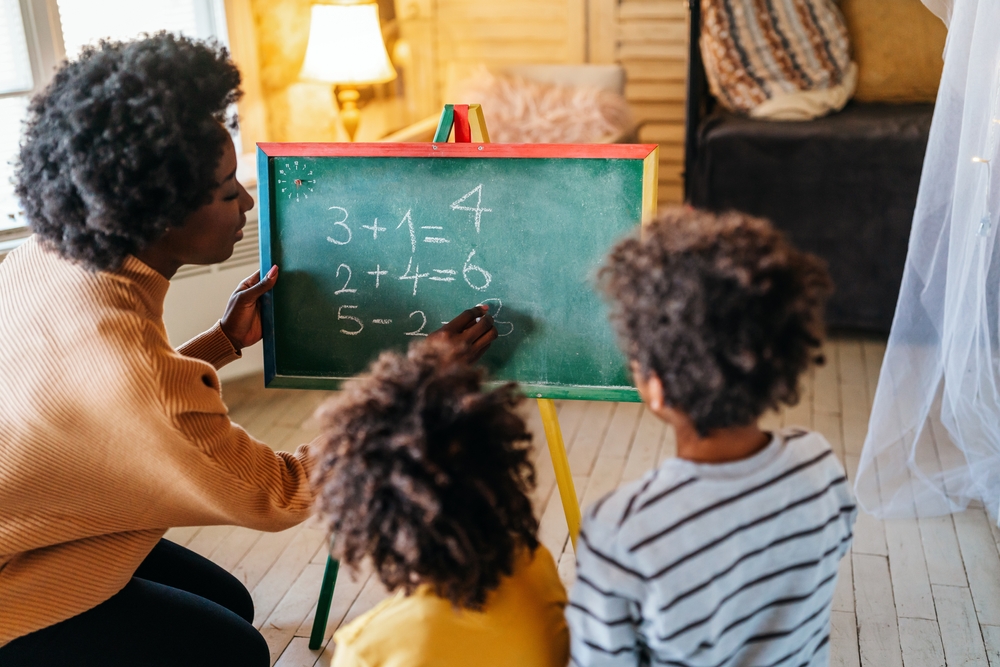This story was originally published by The Hechinger Report.
ASTON, Pa. — In Jodie Murphy’s kindergarten class, math lessons go beyond the basics of counting and recognizing numbers.
On a recent morning, the children used plastic red and yellow dots for a counting exercise: One student tossed the coin-sized dots onto a cookie sheet while another hid her eyes. The second student then opened her eyes, counted up the dots and picked the corresponding number from a stack of cards.
The dots showed up again a few minutes later in a more complex task. Murphy set a two-minute timer, and students counted as many dot arrays as they could, adding or taking away dots to match a corresponding written number. Four dots next to a printed number 6, for example, meant that students had to draw in two extra dots — an important precursor to learning addition.
Kindergarten may be math’s most important year — it lays the groundwork for understanding the relationship between number and quantity and helps develop “number sense,” or how numbers relate to each other, experts and researchers say.

Kindergarten teachers can use an abacus to teach a deeper understanding of counting, the base ten system, and addition and subtraction.
Teaching is often too focused on early skills like counting, instead of building a bridge to later math learning
But too often teachers spend that crucial year reinforcing basic information students may already know. Research shows that many kindergarteners learn early on how to count and recognize basic shapes — two areas that make up the majority of kindergarten math content. Though basic math content is crucial for students who begin school with little math knowledge, a growing body of research argues more comprehensive kindergarten math instruction that moves beyond counting could help more students become successful in math later on.
Because so many students nationally are struggling in math — a longstanding challenge made worse by remote schooling during the pandemic — experts and educators say more emphasis needs to be put on foundational, early childhood math. But for a variety of reasons, kindergarten often misses the mark: Math takes a backseat to literacy, teachers are often unprepared to teach it, and appropriate curriculum, if it exists at all, can be scattershot, overly repetitive — or both.
Manipulating numbers in different ways, part of a supplemental math curriculum for Murphy’s whole class at Hilltop Elementary in this suburb of Philadelphia, is an attempt to address those problems. In an effort to improve math achievement district-wide, all elementary students in the Chichester School District get an extra 30-minute daily dose of math. In kindergarten, the extra time is spent on foundational skills like understanding numbers and quantity, but also the basics of addition and subtraction, said Diana Hanobeck, the district’s director of curriculum and instruction.
[Related: You probably don’t have your preschooler thinking about math enough
Chichester district leaders say implementing the intervention, called SpringMath, along with other steps that include hiring a math specialist for each school, has brought urgent attention to students’ math achievement by bringing more students to mastery — and a lot of that has to do with how much students are learning in kindergarten. Student math achievement, which dropped to a low of 13.5 percent of students proficient or advanced during the pandemic, has more than doubled across grades since the intervention began, although still below the state average. Last spring, 47 percent of the district’s fourth graders were proficient or advanced in math on the Pennsylvania System of School Assessment test.
“The intervention is very targeted by skill and gives teachers data for each student,” said Hanobeck. “We are seeing it close gaps for students, and they are more able to access elementary school math.”
Murphy, the kindergarten teacher, said that while some students arrive at school able to do “rote counting,” others arrive with no prior knowledge or a very limited understanding of numbers and counting. The interventions have improved all students’ accuracy and fluency in more complex tasks, such as being able to count up or down from a number like 16 or 20, and adding and subtracting numbers up to 5.
“It used to take all year for some students to count on from different starting points, that’s actually really hard for kids to do,” Murphy said. “Students are meeting their goals far faster now. We are moving on, but also moving deeper.”

Studio.G photography/Shutterstock
Tactile activities like using the abacus combined with innovative games help motivate younger students.
That deep thought is important, even in the earliest grades. Kindergarten math proficiency is especially predictive of future academic success in all subjects including reading, research has shown. In one study, students’ number competence in kindergarten — which includes the ability to understand number quantities, their relationships to each other, and the ability to join and separate sets of numbers, like 4 and 2 making 6 — presaged mathematical achievement in third grade, with greater number competence leading to higher math achievement.
It’s also the time when learning gaps between students are at their smallest, and it’s easier to put all students on equal footing. “Kindergarten is crucial,” said University of Oregon math education researcher Ben Clarke. “It’s well-documented in the research literature that gaps start early, grow over time and essentially become codified and very hard to remediate.”
But the math content commonly found in kindergarten — such as counting the days on a calendar — is often embedded within a curriculum “in which the teaching of mathematics is secondary to other learning goals,” according to a report from the National Academies of Science. “Learning experiences in which mathematics is a supplementary activity rather than the primary focus are less effective” in building student math skills than if math is the main goal, researchers wrote.
[Related: Teachers conquering their math anxiety]
The math students are taught in kindergarten often progresses no further than basic counting and shapes. In a 2013 study, researcher and University of Colorado Boulder associate professor Mimi Engel found that students who spent more time on the advanced concepts in kindergarten learned more math. Engel hypothesizes that exposure to more advanced content in kindergarten may help students in later grades when content grows more complex.
“We want some amount of repetition across grades in content,” Engel said. “There’s variation in kids’ skill sets when they start kindergarten, and, as a teacher, there are a number of reasons why you want to start with the basics, and scaffold instruction. But what I’m interested in is: when does repetition become redundancy?”
According to researcher Amanda VanDerHeyden, founder of SpringMath, breaking numbers apart and putting them back together and understanding how numbers relate to each other does more to help develop kindergarteners’ mathematical thinking than counting alone. Students should move from using concrete objects to model problems, to using representations of those objects and then to numbers in the abstract — like understanding that the number 3 is a symbol for three objects.
To improve students’ math skills, some schools and districts have recently upgraded the math curriculum and materials teachers use, so they are able to build increasingly complex skills in an organized, orderly way.
Kindergarteners in Hailey Lang’s classroom at Dr. William Burrus Elementary School in Hendersonville, Tennessee, were recently counting penguins — a digital whiteboard showed a photo of a mother penguin with seven fuzzy babies in tow.
“Can we make a math drawing about this picture? No details, you can just use little circles,” Lang said. Students drew one big circle and seven smaller circles on their papers to represent the penguins. Then they translated the circles into a number sentence: 1 (big circle) + 7 (small circles) = 8.

Marius Pirvu/Shutterstock
Young boy solves math equations using a visual game technique with different colored counters in circles above the numerals.
The lesson is new to students this year since they adopted the Eureka Math curriculum. It’s what Sumner County Superintendent Scott Langford calls “high-quality” instructional material, with lessons that move students beyond simply counting objects like penguins. Students look at penguins in a picture, translate them into representational circle drawings, then finally move on to their abstract number quantities.
Sumner County elementary coordinator Karen Medana said she appreciates the fact that the curriculum offers explicit guidance for teachers and builds on a sequence of skills.
One reason for redundancy in kindergarten math may be that classrooms lack cohesive materials that progress students through skills in an orderly way. A 2023 report from the Center for Education Market Dynamics showed that only 36 percent of elementary schools use high-quality instructional materials, as defined by EdReports, a nonprofit organization that evaluates curricula for rigor, coherence and usability. Eureka Math is one of several math programs that meet EdReports’ standards.
[Related: how to boost math skills in the early grades]
Often teachers are left to gather their own math materials outside the school’s curriculum. The Brookings Institution reports that large numbers of teachers use a district-approved curriculum as “one resource among many.” Nearly all teachers say they gather resources from the internet and sites like Teachers Pay Teachers — meaning what students learn varies widely, not only from district to district, but from classroom to classroom.
What students learn might not even be aligned from one grade to another. In a new, unpublished paper still in revision, researcher Engel found “notable inconsistencies” between pre-K and kindergarten classroom math content and how it is taught in New York City schools. Engel said results suggest that in many classrooms, kindergarten math might be poorly aligned with both pre-K and elementary school.
When teachers have access to well-aligned materials, students may learn more. At Marcus Hook Elementary, a Title I elementary school in the Chichester District, kindergarten teacher Danielle Adler’s students were deep into first grade addition, using numbers up to 12. They had already completed all the SpringMath kindergarten math skills in March, so she let them keep going.
“In the past we did focus more on counting, recognizing numbers and counting numbers,” Adler said, “But over the last three years I’ve seen the kids’ skills grow tremendously. Not only what they’re expected to do, but what they’re capable of doing has grown.”
What kindergarteners are expected to do at school has changed dramatically over the last 30 years, including more time spent on academic content. Adler and other kindergarten teachers agree that they hold higher expectations for today’s students, spend more time on teacher-directed instruction and substantially less time on “art, music, science and child-selected activities.”
Some worry that increasing time spent on academic subjects like math, and pushing kindergarten students beyond the basics of numbers and counting, will be viewed as unpleasant “work” that takes away from play-based learning and is just not appropriate for 5- and 6-year-olds, some of whom are still learning how to hold a pencil.
Engel said kindergarteners can be taught more advanced content and are ready to learn it. But it should be taught using practices shown to work for young children, including small group work, hands-on work with objects such as blocks that illustrate math concepts, and learning through play.
[Related: How can you help your kids get better at math?]
Mathematician John Mighton, the founder of the curriculum JUMP Math, said it’s a mistake to believe that evidence-based instructional practices must be laborious and dull to be effective. He has called on adults to think more like children to make more engaging math lessons.
“Children love repetition, exploring small variations on a theme and incrementally harder challenges much more than adults do,” he wrote — all practices supported by evidence to increase learning.
Simple lessons, when done well, can teach complex ideas and get children excited.
“People say kids don’t have the attention,” to learn more advanced concepts, he said, but he strongly believes that children have more math ability than adults give them credit for. Getting students working together, successfully tackling a series of challenges that build on each other, can create a kind of collective effervescence — a feeling of mutual energy and harmony that occurs when people work toward a common goal.
That energy overflowed in Adler’s classroom, for example, as students excitedly colored in graphs showing how many addition problems they got correct, and proudly showed off how the number correct had grown over time.
[Related: The power of touch is vital for both reading and writing]
VanDerHeyden pointed out that, for young kids, much of a math intervention should look and feel like a game.
It’s often harder than it looks to advance kindergarten skills while keeping the fun — elementary teachers often say they have low confidence in their own abilities to do math or to teach it. Research suggests that teachers who are less confident in math might not pay enough attention to how students are learning, or even spend less time on math in class.
Teachers like Murphy have made some tweaks geared to engaging students. In class she calls SpringMath “math games,” and refers to timed fluency tests as “math races.” She even turned choosing a partner into a game, by spinning a wheel to see who students will get.
“We can do all these little things so they’re having fun while they’re learning,” Murphy said.
***
Holly Korbey is an education journalist writing about teachers, parents, and schools for a national audience. Her work has appeared in The Washington Post, The New York Times, The Atlantic, The Boston Globe, and Medium’s Bright. Korbey is a regular contributor on education for Edutopia as well as NPR’s MindShift blog, and is the author of Building Better Citizens, a book about civics education.
This story about kindergarten math was produced by The Hechinger Report, a nonprofit, independent news organization focused on inequality and innovation in education. Sign up for Hechinger’s newsletter.
This story also appeared in The Philadelphia Inquirer.






























